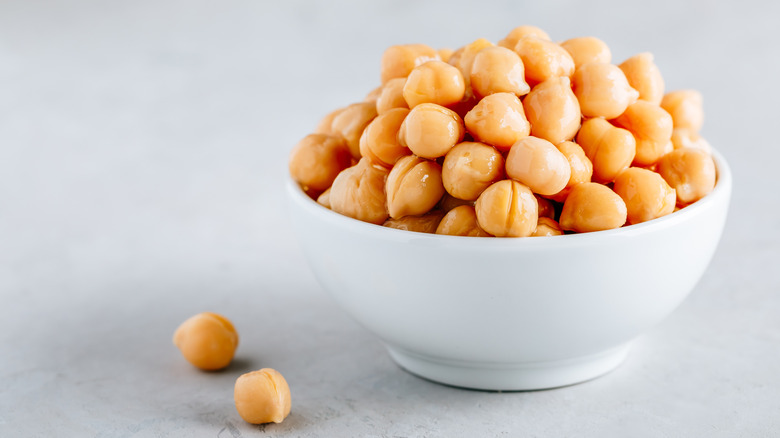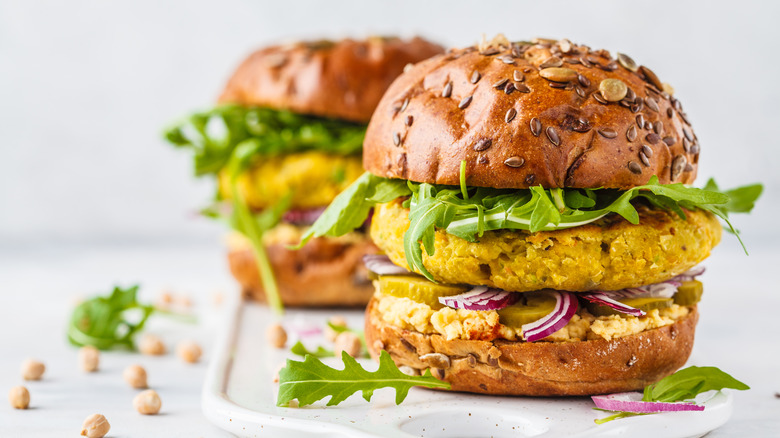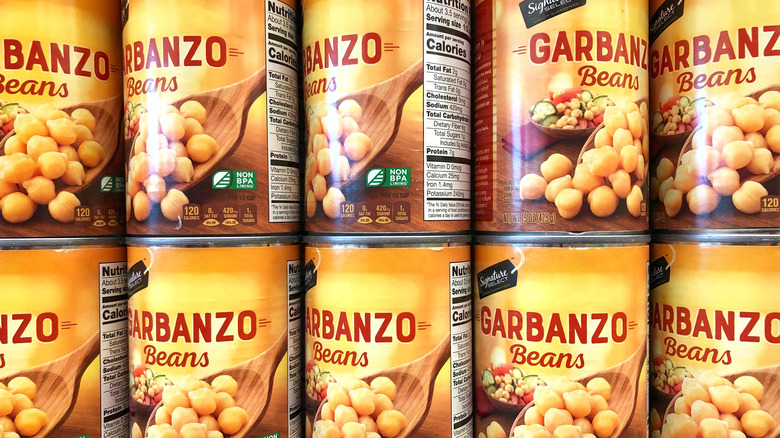What's The Difference Between Chickpeas And Garbanzo Beans?
Searching the grocery store shelves for the perfect ingredient you need can take time. So many different brands sell the same items, and even more of the same seem to pop up regardless. Trips to the supermarket can be overwhelming if you don't prepare yourself. And if you're not careful, they can even become a dangerous free for all — what's known generally as "forget the grocery list, just grab anything that looks good and, most importantly, run for your life." That strategy may work in a pinch, but what if it means reaching for the wrong ingredient?
Picture this scenario: You want to make a healthy crispy chickpea snack at home, but the only thing available are cans of garbanzo beans. The picture on the can might look like chickpeas — but are garbanzo beans really the same thing? You might be racking your brain here, but don't run yourself in circles. Learn the facts about what chickpeas are and never falter in the face of garbanzo beans again. (And as an aside: to avoid those future in-store panics in general, remember to choose the best grocery store near you and stick to that grocery list.)
Why you should be all about chickpeas
Before we tackle the truth behind the differences between chickpeas and garbanzo beans, let's get into what chickpeas are in the first place. Are they a type of pea? A bean? According to The New York Times, they're neither. In reality, chickpeas are part of a versatile superfood group called legumes. In the same category as black beans and lentils, these affordable foodstuffs are actually mild-tasting seeds that come from protein-rich "pods" (via Taste).
Something between a vegetable and a protein, chickpeas can add texture and nutrients to almost any meal. Hey, they can even become anything all on their own — almost as if they have the power of transfiguration. Chickpeas can be turned into anything from flour, burgers, dips, and soups. They can be dried or canned, and are frequently sold in both respective forms. Their mild yet satisfying taste means endless options for using chickpeas in any dish.
One of the absolute best things about chickpeas is that it is an especially healthy food item. Chock full of protein, chickpeas are a perfect way for people to squeeze in some extra nutrients, particularly for vegans and vegetarians, per Healthline. Chickpeas also contain an abundance of other vitamins, including potassium, folate, and iron, just to name a few (via Eating Well). From a refreshing chickpea salad to spiced aloo pakoras, chickpeas are a perfect base for almost any kind of meal you can dream of. So, how do garbanzo beans compare in the face of all these positives?
Choose your fighter: Chickpeas or garbanzo beans?
Let's finally circle back to the main questions at hand: What's the difference between chickpeas and garbanzo beans? And if they're different, which is best? Well, no need to ponder over replacements or equivalents, because they are in fact the same food, per Healthline. That's right, garbanzo beans and chickpeas are interchangeable names for the same set of legumes. But why?
According to Healthline, it all boils down to the many different varieties of chickpeas out there. The Kabuli variety of chickpeas is the type typically labeled as garbanzo beans in grocery stores, while the variety normally labeled chickpeas are the desi variety.
While both chickpea varietals might have some differences between them, those differences are few and far between when it comes to vitamin content or taste. According to the USA Dry Pea & Lentil Council, a non-profit organization, the dissimilarities between chickpeas and garbanzo beans are mostly in relation to size and color.
Another reason for the interchangeable names for the same legume has to do with language. Garbanzo is the Spanish term for chickpea, while "chickpea" is commonly used as an English phrase (via Bon Appétit). But now that you know garbanzo beans and chickpeas are one and the same — well, which one will you pick up?


